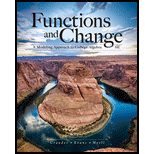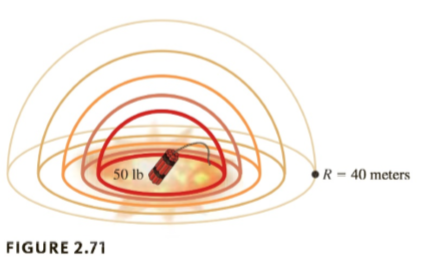
Radius of a Shock Wave An explosion produces a spherical shock wave whose radius R expands rapidly. The rate of expansion depends on the energy E of the explosion and the elapsed time t since the explosion. For many explosions, the relation is approximated closely by
Here R is the radius in centimeters, E is the energy in ergs, and t is the elapsed time in seconds. The relation is valid only for very brief periods of time, perhaps a second or so in duration.
a. An explosion of 50 pounds of TNT produces an energy of about
b. A nuclear explosion releases much more energy than conventional explosions. A small nuclear device of yield 1 kiloton releases approximately
c. The shock wave from a certain explosion reaches a point 50 meters away in 1.2 seconds. How much energy was released by the explosion? The values of E in parts a and b may help you set an appropriate window.
(Note: In 1947, the government released film of the first nuclear explosion in 1945, but the yield of the explosion remained classified. Sir Geoffrey Taylor used the film to determine the rate of expansion of the shock wave and so was able to publish a scientific paper concluding correctly that the yield was in the 20-kiloton range.)

Want to see the full answer?
Check out a sample textbook solution
Chapter 2 Solutions
Functions and Change: A Modeling Approach to College Algebra (MindTap Course List)
- Practice Assignment 5.6 Rational Functions M Practice Assig Practice Assignment 5.6 Rational Functions Score: 120/150 Answered: 12/15 Question 10 A Write an equation for the function graphed below 5 + 4 1 2 H + + -7 -6 -5 -4 -3 -2 -1 2 34567 | -2 ర y = Question Help: Video Message instructor Post to forum Submit Questionarrow_forwardit's not algebra 4th gradearrow_forwardCan you tell me if I answered and showed my work correctlyarrow_forward
- Q1: A: Let M and N be two subspace of finite dimension linear space X, show that if M = N then dim M = dim N but the converse need not to be true. B: Let A and B two balanced subsets of a linear space X, show that whether An B and AUB are balanced sets or nor verly A:LeLM be a subset of a linear space X, show that M is a hyperplane of X iff there exists fe X'/[0] and a EF such that M = {x Ex/f(x) = = a}. B:Show that every two norms on finite dimension linear space are equivalent C: Let f be a linear function from a normed space X in to a normed space Y, show that continuous at x, EX iff for any sequence (x) in X converge to x, then the sequence (f(x)) converge to (f(x)) in Y.arrow_forward2/26 Delta Math | Schoology X Unit 4: Importance of Education X Speech at the United Nations b x Book Thief Part 7 Summaries x + > CA Materials pdsd.schoology.com/external_tool/3157780380/launch ☆ MC Updates Grades Members BrainPOP Canva for Education DeltaMath Discovery Education FactCite Gale In Context: High Sc. Graw McGraw Hill K-12 SSO Draw a line representing the "rise" and a line representing the "run" of the line. State the slope of the line in simplest form. Click twice to plot each segment. Click a segment to delete it. 10 9 8 5 сл y Hill Nearpod 3 2 Newsela -10 -9 -8 -7 b -5 -4-3-2 -1 1 23 4 5 b 7 89 10 Scholastic Digital Mana. World Book Online Information Grading periods MP3: 2025-01-25-2025-03- 31, MP4: 2025-04-01-2025- 06-13 ← 2 M -> C % 95 54 # m e 4 7 巴 DELL A t y & * ) 7 8 9 . i L Feb 27 12:19 US + 11arrow_forwardLet & be linear map from as Pacex into aspace and {X1, X2, – 1— x3 basis for x show that f a one-to-one isf {f(x1), f (xx); — F (Kn) } linearly independent. மம் let M be a Proper sub space of aspace X then M is ahyper space iff for any text&M X=. C) let X be a linear space and fe X1{0} Show that is bjective or not and why? ***********arrow_forward
- Q₁/(a) Let S and T be subsets of a vector space X over a field F such that SCT,show that whether (1) if S generate X then T generate X or not. (2) if T generate X then S generate X or not. (b) Let X be a vector space over a field F and A,B are subsets of X such that A is convex set and B is affine set, show that whether AnB is convex set or not, and if f be a function from X into a space Y then f(B) is an affine set or not. /(a) Let M and N be two hyperspaces of a space X write a condition to prove MUN is a hyperspace of X and condition to get that MUN is not hyperspace of X. Write with prove application n Panach theoremarrow_forwardMatch the division problem on the left with the correct quotient on the left. Note that the denominators of the reminders are omitted and replaced with R. 1) (k3-10k²+k+1) ÷ (k − 1) 2) (k4-4k-28k45k+26)+(k+7) 3) (20k+222-7k+7)+(5k-2) 4) (3+63-15k +32k-25)+(k+4) 5) (317k 13) ÷ (k+4) - 6) (k-k+8k+5)+(k+1) 7) (4-12k+6) + (k-3) 8) (3k+4k3 + 15k + 10) ÷ (3k+4) A) 3k3-6k29k - 4 B) 4k2 + 6 R 7 C)²-9k-8- R D) 4k2+6x+1+ E) 10 Elk³-5-12 R 9 F) k² - 4k R 9 R G) k3-3k2-7k+4 H) k³-k²+8 - 3 R - R 9 Rarrow_forwardAnswer choices are: 35 7 -324 4 -9 19494 5 684 3 -17 -3 20 81 15 8 -1 185193arrow_forward
- Algebra & Trigonometry with Analytic GeometryAlgebraISBN:9781133382119Author:SwokowskiPublisher:Cengage
 Linear Algebra: A Modern IntroductionAlgebraISBN:9781285463247Author:David PoolePublisher:Cengage Learning
Linear Algebra: A Modern IntroductionAlgebraISBN:9781285463247Author:David PoolePublisher:Cengage Learning
 Functions and Change: A Modeling Approach to Coll...AlgebraISBN:9781337111348Author:Bruce Crauder, Benny Evans, Alan NoellPublisher:Cengage Learning
Functions and Change: A Modeling Approach to Coll...AlgebraISBN:9781337111348Author:Bruce Crauder, Benny Evans, Alan NoellPublisher:Cengage Learning
 Algebra: Structure And Method, Book 1AlgebraISBN:9780395977224Author:Richard G. Brown, Mary P. Dolciani, Robert H. Sorgenfrey, William L. ColePublisher:McDougal Littell
Algebra: Structure And Method, Book 1AlgebraISBN:9780395977224Author:Richard G. Brown, Mary P. Dolciani, Robert H. Sorgenfrey, William L. ColePublisher:McDougal Littell





